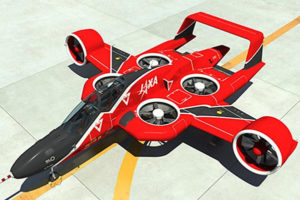 Japanese aerospace research agency has been developing a two-seat airtaxi that can be used for passenger traffic between cities in a mountainous area. The new aircraft will be capable of vertical takeoff and landing, as well performing a fast horizontal flight. Externally, the machine is different from the concepts of airtaxi, presented by European and American companies, and more like a fighter or aircraft.
Japanese aerospace research agency has been developing a two-seat airtaxi that can be used for passenger traffic between cities in a mountainous area. The new aircraft will be capable of vertical takeoff and landing, as well performing a fast horizontal flight. Externally, the machine is different from the concepts of airtaxi, presented by European and American companies, and more like a fighter or aircraft.
Japan has a mountainous terrain, which covers about 75% of the country’s territory. Because of this, the transport connection between cities in the country takes a long time and the machines often have to navigate through the serpentine or loop between the mountains. The new project of the Agency for Aerospace Exploration of Japan is designed to help determine whether light passenger air transport will significantly shorten the time to travel between cities.
The project was named Type 28. As part of the development program, designers have already created an unmanned aerial vehicle for testing some technical solutions. The first flight tests of the apparatus in the room were already held and were recognized as successful. UAV is made on a two-beam scheme, and in the tail section between the beams and the fuselage there are four vertical fans. They will be responsible for vertical takeoff and landing, as well as providing lift at low horizontal flight speeds.
The device is equipped with a wing, at the ends of which are rotary fans. On takeoff or landing they will be installed vertically, as during the horizontal flight will be rotated 90 degrees, creating a driving force. The tail beams of the apparatus have a U-shaped tail unit. The UAV is equipped with a three-post chassis. The prototype Type 28, whose length is two meters, is made electric. The full-size demonstrator of the new airtaxi technology will also be electric.
The project envisages the placement of a double cabin in the front of the fuselage for the pilot and passenger or for two passengers – the designers have not yet decided whether the airtaxi will be optional manned or completely unmanned. The pilot and the passenger will be placed in tandem, that is, one after another. Other details about the prospective aircraft are still unknown. Also, the timing of the commencement of flight tests of a full-size technology demonstrator has not yet been determined.
In mid-July this year it became known that the European aircraft construction concern Airbus had planned flight tests of its city air taxi CityAirbus at the end of 2018. The first airtaxi prototype, called Alpha-Demonstrator, will be an unmanned reduced version of a prospective machine. The project involves the creation of a passenger quadrocopter capable of carrying from two to four people at a distance of up to 60 kilometers. The cruise speed of the air taxi will be 120 kilometers per hour.